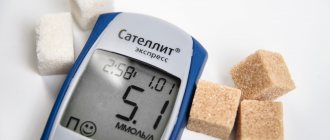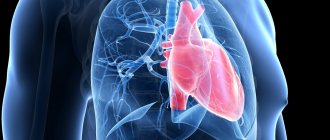13.11.2017
Diabetes mellitus is a group of diseases of the endocrine system that develop due to the lack or absence of insulin (hormone) in the body, resulting in a significant increase in the level of glucose (sugar) in the blood (hyperglycemia).
Diabetes mellitus is mainly a chronic disease. It is characterized by metabolic disorders - fat, carbohydrate, protein, water-salt and mineral. In diabetes mellitus, the functions of the pancreas, which actually produces insulin, are impaired.
Insulin is a protein hormone produced by the pancreas, the main function of which is to participate in metabolic processes - the processing and conversion of sugar into glucose, and the further transport of glucose into cells. In addition, insulin regulates blood sugar levels.
In diabetes, cells do not receive the necessary nutrition. It is difficult for the body to retain water in the cells, and it is excreted through the kidneys. Disruptions occur in the protective functions of tissues, the skin, teeth, kidneys, and nervous system are affected, the level of vision decreases, atherosclerosis and hypertension develop.
In addition to humans, the disease can also affect some animals, such as dogs and cats.
Diabetes mellitus is inherited, but it can also be acquired in other ways.
How does diabetes develop?
The hormone insulin converts sugar into glucose, which is an energy substance necessary for the normal functioning of body cells. When there is a failure in the production of insulin by the pancreas, disturbances in metabolic processes begin. Glucose is not delivered to the cells and settles in the blood. The cells, in turn, starving, begin to malfunction, which externally manifests itself in the form of secondary diseases (diseases of the skin, circulatory system, nervous and other systems). At the same time, there is a significant increase in blood glucose (hyperglycemia). The quality and effect of blood deteriorate. This whole process is called diabetes.
Why is high blood sugar harmful?
High blood sugar levels can cause dysfunction of almost all organs, including death. The higher the blood sugar level, the more obvious the result of its action, which is expressed in:
- obesity;
- glycosylation (sugarification) of cells;
- intoxication of the body with damage to the nervous system;
- damage to blood vessels;
- the development of secondary diseases affecting the brain, heart, liver, lungs, gastrointestinal tract, muscles, skin, eyes;
- manifestations of fainting states, coma;
- lethal outcome.
Symptoms of diabetes
Diabetes mellitus in most cases develops gradually, and only occasionally does the disease develop rapidly, accompanied by an increase in glucose levels to a critical level with various diabetic comas.
The first signs of diabetes
- constant feeling of thirst;
- constant dry mouth;
- increased urine output (increased diuresis);
- increased dryness and severe itching of the skin;
- increased susceptibility to skin diseases, pustules;
- prolonged wound healing;
- a sharp decrease or increase in body weight;
- increased sweating;
- muscle weakness.
Signs of diabetes
- frequent headaches, fainting, loss of consciousness;
- blurred vision;
- heart pain;
- numbness in the legs, pain in the legs;
- decreased skin sensitivity, especially on the feet;
- swelling of the face and legs;
- liver enlargement;
- prolonged wound healing;
- high blood pressure;
- the patient begins to smell of acetone.
Complications of diabetes
Diabetic neuropathy - manifested by pain, burning, numbness of the extremities. It is associated with disruption of metabolic processes in nervous tissue.
Edema. Swelling in diabetes can spread locally - on the face, legs, or throughout the body. Swelling indicates a disturbance in the functioning of the kidneys, and depends on the degree of heart failure. Asymmetrical swelling indicates diabetic microangiopathy.
Leg pain. Pain in the legs with diabetes, especially when walking and other physical activity on the legs, may indicate diabetic microangiopathy. Leg pain during rest, especially at night, indicates diabetic neuropathy. Often, leg pain in diabetes is accompanied by burning and numbness in the feet or some parts of the legs.
Trophic ulcers. Trophic ulcers in diabetes mellitus, after pain in the legs, are the next stage in the development of diabetic angio- and neuropathy. The types of wounds differ greatly from each other, so treatment of trophic ulcers in diabetes is prescribed after an accurate diagnosis, noting the smallest symptomatic details. The negative impact of ulcers is a decrease in the sensitivity of the affected feet, which occurs due to damage to the nerves when the foot is deformed. In some places, this results in corns, under which hematomas are formed with further suppuration. All these processes often occur unnoticeably, so people, as a rule, go to the doctor whose leg is already very swollen, red, and has a trophic ulcer.
Gangrene. Gangrene in diabetes mellitus in most cases is the result of diabetic angiopathy. The onset of gangrene occurs due to damage to small and large blood vessels in the area of the lower limb, most often the big toe. In this case, the patient feels severe pain in the foot. Redness of the damaged area occurs, which over time gives way to bluish skin, and after some time, this area becomes covered with black spots and blisters with cloudy contents. The process is irreversible - amputation of the limb is necessary. The optimal level of limb amputation is the lower leg.
High and low pressure. High and low pressure in diabetes mellitus is observed simultaneously in two points of the body. In the upper part of the body (in the brachial artery) there is increased pressure, which indicates kidney damage (diabetic nephropathy). In the lower part of the body (in the vessels of the legs) there is low pressure, which indicates the degree of diabetic angiopathy of the lower extremities.
Coma. Coma with diabetes occurs extremely quickly. A sign of coma in diabetes is the patient's lethargy and fainting. Before this, a person may smell of acetone coming from the mouth when breathing, which is due to extreme intoxication of the body. In addition, the patient may break into a cold sweat. If the patient exhibits at least one of these signs, he must be taken to a medical facility immediately.
Causes of glucose imbalance
There are two types of blood sugar disorders:
- Hyperglycemia: glucose level exceeds 5.5 mmol/l. In persons over 60 years of age, a level of 5.9-6.3 mmol/l is considered normal.
- Hypoglycemia: glucose level below 3.3-3.5 mmol/l.
Each of these conditions has its own causes and provoking factors, which should be discussed separately.
Hyperglycemia
- Diabetes;
- neoplasms in the liver;
- severe neuropsychological stress;
- regular overeating (gluttony);
- lack of B vitamins;
- uncontrolled use of certain groups of medications: antidepressants, β-blockers, diuretics, corticosteroids, etc.
Hypoglycemia
- excessive physical activity leading to excess glucose consumption;
- violations of the rules for taking glucose-lowering medications;
- Irregular meals or poor diet;
- chronic liver, kidney and/or heart failure;
- hepatitis or insulinoma (pancreatic tumor);
- lack of hormones: glucagon, cortisol, somatropin;
- congenital disorders of insulin secretion;
- chronic alcoholism;
- anorexia.
Diabetes mellitus type 2 - symptoms and treatment
Treatment of type II diabetes involves solving the main problems:
- compensate for the lack of insulin;
- correct hormonal and metabolic disorders;
- implementation of therapy and prevention of complications.
To solve them, the following treatment methods are used:
- diet therapy;
- physical exercise;
- use of glucose-lowering drugs;
- insulin therapy;
- surgical intervention.
Diet therapy
The diet for type II diabetes, like a regular diet, requires an optimal ratio of the main substances contained in foods: proteins should make up 16% of the daily diet, fats - 24%, and carbohydrates - 60%. The difference between the diet for type II diabetes lies in the nature of the carbohydrates consumed: refined sugars are replaced by slowly digestible carbohydrates. Since this disease occurs in obese people, weight loss is the most important condition for normalizing blood glucose levels. In this regard, a caloric diet is recommended, in which the patient will lose 500 g of body weight weekly until reaching the ideal weight. However, weekly weight loss should not exceed 2 kg, otherwise this will lead to excessive loss of muscle rather than fat tissue. The number of calories required for the daily diet of patients with type II diabetes is calculated as follows: women need to multiply their ideal weight by 20 kcal, and men by 25 kcal.
When following a diet, it is necessary to take vitamins, since during diet therapy they are excessively excreted in the urine. The lack of vitamins in the body can be compensated by rational consumption of healthy foods, such as fresh herbs, vegetables, fruits and berries. During the winter and spring periods, it is possible to take vitamins in yeast form.
Exercise stress
A correctly selected system of physical exercises, taking into account the course of the disease, age and present complications, contributes to a significant improvement in the condition of the patient with diabetes. This treatment method is good because the need to use insulitis practically disappears, since during physical activity glucose and lipids are burned without its participation.
Treatment with glucose-lowering drugs
Today, derivatives of glucose-lowering drugs are used:
- sulfonylureas (tolbutamide, glibenclamide);
- biguanides, which reduce gluconeogenesis in the liver and increase the sensitivity of muscles and liver to insulin (metformin);
- thiazolidinediones (glitazones), similar in properties to biguanides (pioglitazone, rosiglitazone);
- alpha-glucosidase inhibitors, which reduce the rate of glucose absorption in the gastrointestinal tract (acarbose);
- agonists of glucagon-like peptide-1 receptors, stimulating the synthesis and secretion of insulin, reducing liver glucose production, appetite and body weight, slowing down the evacuation of the food bolus from the stomach (exenatide, liraglutide);
- depeptidyl peptidase-4 inhibitors, which also stimulate the synthesis and secretion of insulin, reduce the production of glucose by the liver, do not affect the rate of evacuation of food from the stomach and have a neutral effect on body weight (sitagliptin, vildagliptin);
- inhibitors of sodium-glucose cotransporter type 2 (gliflozin), which reduce the reabsorption (absorption) of glucose in the kidneys, as well as body weight (dapagliflozin, empagliflozin).
Insulin therapy
Depending on the severity of the disease and the complications that arise, the doctor prescribes insulin. This treatment method is indicated in approximately 15-20% of cases. Indications for the use of insulin therapy are:
- rapid weight loss for no apparent reason;
- the occurrence of complications;
- insufficient effectiveness of other glucose-lowering drugs.
Surgery
Despite the many hypoglycemic drugs, the question of their correct dosage, as well as patient adherence to the chosen method of therapy, remains unresolved. This, in turn, creates difficulties in achieving long-term remission of type II diabetes. Therefore, surgical therapy for this disease—bariatric or metabolic surgery—is becoming increasingly popular around the world. The IFD considers this method of treating patients with type II diabetes to be effective. Currently, more than 500,000 bariatric surgeries are performed worldwide each year. There are several types of metabolic surgery, the most common being gastric bypass and mini gastric bypass.[4]
Roux-en-Y gastric bypass
During bypass surgery, the stomach is divided below the esophagus so that its volume is reduced to 30 ml. The remaining large part of the stomach is not removed, but is sealed, preventing food from entering it.[5] As a result of the intersection, a small stomach is formed, to which the small intestine is then sewn, 1 m away from its end. This way, food will go directly into the large intestine, while its processing by digestive juices will be reduced. This, in turn, provokes irritation of L-cells in the ileum, which contributes to a decrease in appetite and an increase in the growth of cells that synthesize insulin.
Mini gastric bypass
The main difference between mini-gastrobypass and classic gastric bypass is the reduction in the number of anastomoses (connections of intestinal segments).[2] When performing a traditional operation, two anastomoses are performed: the connection of the stomach and small intestine and the connection of different parts of the small intestine. With mini-gastrobypass, there is only one anastomosis - between the stomach and the small intestine. Due to the small volume of the newly formed stomach and the rapid entry of food into the small intestine, the patient has a feeling of fullness even after eating small portions of food.
Other types of bariatric surgery include:
- gastropplication - suturing the stomach to prevent it from stretching;[8]
- sleeve gastroplasty (otherwise called laparoscopic longitudinal gastrectomy) - cutting off most of the stomach and forming a 30 ml gastric tube, which promotes rapid saturation and also allows you to avoid following a strict diet;
- Gastric banding is a reduction in the volume of the stomach using a special ring (band) placed on the upper part of the stomach (this intervention is reversible).
Contraindications to surgical treatment are the presence of esophagitis (inflammation of the mucous membrane of the esophagus), varicose veins of the esophagus, portal hypertension, liver cirrhosis, gastric or duodenal ulcer, chronic pancreatitis, pregnancy, alcoholism, severe diseases of the cardiovascular system or mental illness. disorders, as well as long-term use of hormonal drugs.
Symptoms of hyperglycemia
The following clinical signs indicate elevated blood sugar:
- constant strong unquenchable thirst, often accompanied by a feeling of dry mouth;
- slow healing of wounds, as well as their increased tendency to infection and suppuration;
- frequent urination with small volumes of single urine output;
- regular occurrence of infectious diseases, especially those affecting the mucous membranes (for example, candidiasis);
- causeless loss of body weight;
- decreased visual acuity - sometimes temporary;
- noticeable deterioration in the condition of the skin and hair;
- chronic fatigue, increased fatigue;
- cardiac arrhythmia;
- causeless irritability and nervousness.
Diagnostics
The main diagnostic criterion is waist circumference (more than 94 cm in men and more than 80 in women). If you have abdominal obesity, you have insulin resistance. In second place is arterial hypertension.
Other manifestations of metabolic syndrome (except obesity and hypertension): increased levels of cholesterol, triglycerides, uric acid - also indicate a reduced biological response to insulin.
In addition, infectious pathology, stress, smoking, lack of sleep, and taking a number of medications (such as oral contraceptives, statins) provoke the development of insulin resistance.
A high level of insulin in a blood test with normal glucose is a sign of resistance, but this ratio changes with the development of diabetes.
Skin lesions due to insulin resistance are often visible to the naked eye. This is acanthosis nigricans (acanthosis nigricans) - darkening, thickening of the skin in the area of natural folds (neck, armpits, groin). Acrochordons (skin growths resembling papillomas) on these areas of the body. Dark, dry, flaky elbows.
Signs of hypoglycemia
A decrease in blood sugar levels has fairly clear symptoms, and therefore does not pose any difficulties in diagnosis:
- increased sweating;
- tremor of the limbs;
- high blood pressure;
- chronic tachycardia;
- frequent and causeless nausea;
- constant feeling of weakness, frequent dizziness;
- persistent feeling of hunger;
- pronounced pallor of the skin;
- frequent headaches;
- blurred vision, double vision of visible objects;
- tingling or “ants crawling” sensations throughout the body;
- decreased concentration.
Treatment
Insulin resistance can be influenced in two ways:
- Reduce the need for insulin.
- Increase cell sensitivity to insulin.
The most effective treatment for insulin resistance, based on the cause, is a change in lifestyle and diet (read the article healthy eating), which involves giving up “fast” carbohydrates and rare meals, and proper physical activity.
No less important is compensation for deficiencies of hormones (sex, thyroid), vitamins (vitamin D, group B, etc.), microelements, omega-3 fatty acids, and improvement of metabolic processes. Normalization of night sleep is mandatory.
There are medications that improve cell sensitivity to insulin. In addition to the above, they can also be prescribed by a doctor.









